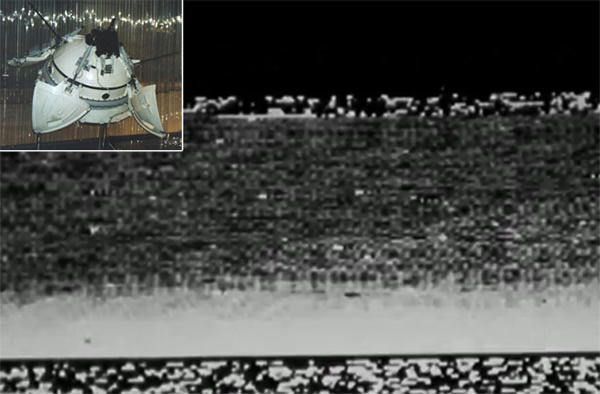The Mysterious Loss of Mars 3
Last week, a once-lost, now possibly found Soviet lander caused a buzz. Russian space enthusiasts found what appears to be the remains of a parachute, heat shield, terminal descent stage and lander of the 1971 Mars 3 mission in pictures taken by NASA’s Mars Reconnaissance Orbiter. And, if further study confirms the debris is the remains of Mars 3, it might help us uncover the mystery of what killed the mission. Because had it lived, Mars 3 would have been awesome.
Mars 3, along with its twin mission Mars 2, was part of the Soviet Project M-71 – M for Mars, 71 meaning it launched during the 1971 window. Mars 2 launched first on May 19; Mars 3 followed on May 21. Both launches were flawless, and both spacecraft followed trajectories that had them arrive at Mars right on schedule in December.
The 10,250-pound Mars 3 spacecraft was comprised of an orbiter and a lander. Once in orbit, the two pieces separated and the 2,500 pound lander housed in a four foot diameter sphere started its descent to the surface. Using a 9.5 foot aeroshell to protect it from the fiery atmospheric entry, a parachute to slow its fall, and retrorockets fired in the final stage of landing, Mars 3 landed safely on December 2, 1971.
The Mysterious Loss of Mars 3
Once on the surface, the sides of the sphere opened like flower petals revealing the suite of instruments. Mars 3 went to study the planet’s atmospheric pressure, temperature, wind velocity, chemical composition of the soil, and the physical-mechanical properties of the soil’s surface layer. It had a scoop to look for signs of life in the soil.
Among Mars 3’s science payload were: a fluxgate magnetometer to measure the strength and direction of a Martian magnetic field; an infrared radiometer to study surface temperature; an infrared photometer; a spectrometer to determine levels of water vapor in the atmosphere; a visible light photometer to study surface and atmospheric reflectivity; a radiometer to study the dielectric permeability; an ultraviolet photometer to study the upper atmosphere; a cosmic ray particles detector; a detector to determine the kinetic energy of electrons and protons; and a charged particles spectrometer. The whole payload was insulated with radiators and powered by batteries, putting a time limit on mission operations.
Mars 3 also carried two telephoto cameras with focal distances of 52 and 350 millimeters. These were designed to send back 360 degree panoramas of the area around the lander, but they had a second purpose. Mars 3, as well as its twin Mars 2 lander, carried a small rover onboard, and the cameras were there to be its virtual eyes.
Alongside Mars 3’s instruments was a ten pound rover called Prop-M. Its was a small box supported on either side by a thick metal ski. That’s how to rovers were meant to move; they would ski rather than rove. It was a design inspired by cold Russian winters and a scant knowledge of Mars’ surface environment.
With the lander safely on the surface and its science payload exposed to the elements, a robotic arm was programmed to pick up the small rover and put it on the surface where it would slowly ski around. The Prop-M couldn’t get far from its lander; a 50-foot umbilical, necessary for data and power transfer, kept the small rover tethered to the lander. But even without full autonomy the little rover could get itself out of trouble with a rudimentary hazard avoidance system. There was a bar on the rover’s leading side. If it hit something, like a rock, it would press the bar back and signal to the rover to turn. As an additional watchful eye, the rover would stop every five feet so the cameras could take a picture and figure out where it was safe to rover next. The rover’s tracks would also be photographed. The disturbed soil could give Soviet scientists clues about what lay beneath the red dust.
But the rover never made it to the surface. None of the science instruments got to probe the secrets of Mars’ atmosphere. Ninety seconds after landing, Mars 3’s lander opened and started transmitting its signal for the Mars 3 orbiter. But the signal didn’t last. Communications stopped after just 20 seconds. Soviet mission scientists weren’t sure what happened. They speculated that the lander had experienced some catastrophic failure, or that something interrupted the communications relay between lander and rover.
Another possibility, and the one that’s frequently cited as the Mars 3 killer, is that the lander arrived in an extremely powerful dust storm that wreaked havoc on the spacecraft. Raging dust could have been powerful enough to knock the whole lander offline for good. But Mars 3 fared better than Mars 2, which smashed into the surface after entering the atmosphere at too steep an angle and its parachute failed to deploy.
Mars 3 did send back an image in its short life, a dark, grainy, noisy look at the Martian surface. It’s not much, but it is the first image ever returned from the red planet and that’s something.(Apr 24, 2013 12:12 PM ET // by Amy Shira Teitel)












